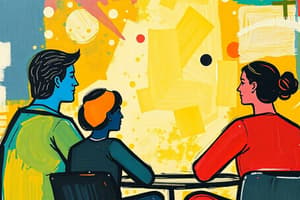Podcast
Questions and Answers
What did Norman Triplett’s bicycle racing observation reveal about cyclists?
What did Norman Triplett’s bicycle racing observation reveal about cyclists?
- Cyclists perform better when there are no distractions.
- Cyclists' times improve when racing together. (correct)
- Cyclists perform equally well alone and in groups.
- Cyclists' times are faster when racing against the clock.
What was Floyd Allport’s experiment focused on?
What was Floyd Allport’s experiment focused on?
- The impact of competition on individual performance.
- The influence of audience on performing arts.
- The effect of others' presence on simple tasks. (correct)
- The impact of group presence on complex problem solving.
Which of the following studies found that the presence of others diminishes learning efficiency?
Which of the following studies found that the presence of others diminishes learning efficiency?
- Bayer’s ant excavation study.
- Dashiell's nonsense syllables experiment. (correct)
- Liu & Yu's online group performance study.
- Garcia-Marques et al. study on face recognition.
What outcome was found in the Larsson’s rat experiment?
What outcome was found in the Larsson’s rat experiment?
What was the key finding of Moscovici et al.'s blue slide experiment?
What was the key finding of Moscovici et al.'s blue slide experiment?
In which experiment did it show that performance improves in the presence of other individuals?
In which experiment did it show that performance improves in the presence of other individuals?
What percentage of jurors reached a consensus after discussion, according to Kalven & Zeisel's jury study?
What percentage of jurors reached a consensus after discussion, according to Kalven & Zeisel's jury study?
Which experiment demonstrated improved accuracy in simple tasks due to the presence of others?
Which experiment demonstrated improved accuracy in simple tasks due to the presence of others?
Which type of study typically identified a negative impact of social presence?
Which type of study typically identified a negative impact of social presence?
In Davis et al.'s studies, what was found to be the best predictor for a jury's decision?
In Davis et al.'s studies, what was found to be the best predictor for a jury's decision?
What phenomenon did Hastie, Penrod, & Pennington's mock jury experiment illustrate?
What phenomenon did Hastie, Penrod, & Pennington's mock jury experiment illustrate?
Which of the following studies is associated with enhancing performance in online groups?
Which of the following studies is associated with enhancing performance in online groups?
What finding was reported by MacCoun & Kerr in their mock jury experiments?
What finding was reported by MacCoun & Kerr in their mock jury experiments?
According to Tindale et al.'s findings, what is true about a minority favoring acquittal?
According to Tindale et al.'s findings, what is true about a minority favoring acquittal?
What was the outcome of Milgram's original obedience study?
What was the outcome of Milgram's original obedience study?
Which factor manipulated in Milgram's studies influenced participants' behaviors?
Which factor manipulated in Milgram's studies influenced participants' behaviors?
What effect did the presence of an audience have on participants learning a task in Blascovich et al.'s experiment?
What effect did the presence of an audience have on participants learning a task in Blascovich et al.'s experiment?
What was the main finding of Blackwell, Trzesniewski, & Dweck's study on intelligence?
What was the main finding of Blackwell, Trzesniewski, & Dweck's study on intelligence?
In Diener & Beaman's Halloween experiment, what factor increased the likelihood of children taking extra candy?
In Diener & Beaman's Halloween experiment, what factor increased the likelihood of children taking extra candy?
In Schütz's marital conflict study, what do couples tend to do more frequently?
In Schütz's marital conflict study, what do couples tend to do more frequently?
What key phenomenon was demonstrated in Stasser & Titus's hiring experiment?
What key phenomenon was demonstrated in Stasser & Titus's hiring experiment?
What was found regarding self-disclosure in Miller, Berg, & Archer’s experiment?
What was found regarding self-disclosure in Miller, Berg, & Archer’s experiment?
What conclusion was drawn from Phelps et al.'s implicit racism study?
What conclusion was drawn from Phelps et al.'s implicit racism study?
What characteristic correlated with higher social acceptance in Deaux’s attachment style experiment?
What characteristic correlated with higher social acceptance in Deaux’s attachment style experiment?
What effect did hypocrisy induction have in Dickerson et al.'s water conservation study?
What effect did hypocrisy induction have in Dickerson et al.'s water conservation study?
What impact did rewards have on intrinsic motivation according to Lepper, Greene, & Nisbett’s study?
What impact did rewards have on intrinsic motivation according to Lepper, Greene, & Nisbett’s study?
What aspect did Aron et al.'s self-expansion experiment focus on in relation to relationships?
What aspect did Aron et al.'s self-expansion experiment focus on in relation to relationships?
What behavior was observed in participants in Haney, Banks, & Zimbardo’s Stanford Prison Experiment?
What behavior was observed in participants in Haney, Banks, & Zimbardo’s Stanford Prison Experiment?
What did Uleman & Blader's college application experiment investigate?
What did Uleman & Blader's college application experiment investigate?
Which potential outcome did not emerge from any of the experiments discussed?
Which potential outcome did not emerge from any of the experiments discussed?
What was one finding of Langer, Blank, & Chanowitz’s study regarding compliance?
What was one finding of Langer, Blank, & Chanowitz’s study regarding compliance?
In Petty, Cacioppo, & Goldman’s personal relevance experiment, how did personal relevance affect persuasion?
In Petty, Cacioppo, & Goldman’s personal relevance experiment, how did personal relevance affect persuasion?
What did Latané, Williams, & Harkins's experiment (1979) reveal about participant behavior in groups?
What did Latané, Williams, & Harkins's experiment (1979) reveal about participant behavior in groups?
What was the main finding of Sweeney’s bicycle experiment (1973)?
What was the main finding of Sweeney’s bicycle experiment (1973)?
Which of the following best describes the outcome of Diener & Wallbom’s Halloween experiment (1976)?
Which of the following best describes the outcome of Diener & Wallbom’s Halloween experiment (1976)?
What does Gabrenya et al.’s cross-cultural experiment (1985) suggest about social loafing?
What does Gabrenya et al.’s cross-cultural experiment (1985) suggest about social loafing?
What was the conclusion of Zimbardo’s electric shock experiment (1970) regarding anonymity?
What was the conclusion of Zimbardo’s electric shock experiment (1970) regarding anonymity?
How did Hardy & Latané's (1986) experiment contribute to the understanding of social loafing?
How did Hardy & Latané's (1986) experiment contribute to the understanding of social loafing?
What does Watson’s anthropological analysis (1973) suggest about depersonalized warriors?
What does Watson’s anthropological analysis (1973) suggest about depersonalized warriors?
In Johnson & Downing’s electric shock experiment (1979), how did uniforms affect behavior?
In Johnson & Downing’s electric shock experiment (1979), how did uniforms affect behavior?
What was the primary finding of Frank & Gilovich's hockey and football analysis?
What was the primary finding of Frank & Gilovich's hockey and football analysis?
In Stoner's risk-taking experiment, which conclusion was drawn about group decision-making?
In Stoner's risk-taking experiment, which conclusion was drawn about group decision-making?
What effect did discussion have on French students according to Moscovici & Zavalloni's experiment?
What effect did discussion have on French students according to Moscovici & Zavalloni's experiment?
Isozaki’s experiment with Japanese students revealed what outcome related to guilty judgments?
Isozaki’s experiment with Japanese students revealed what outcome related to guilty judgments?
What was the main finding of Whyte's business student experiment regarding investment behavior?
What was the main finding of Whyte's business student experiment regarding investment behavior?
What erroneous belief may be held about Myers & Bishop's study concerning racial attitudes?
What erroneous belief may be held about Myers & Bishop's study concerning racial attitudes?
What was the key result of Salganik et al.'s music download experiment?
What was the key result of Salganik et al.'s music download experiment?
What did Bekafigo et al.'s study replicate from Myers & Bishop's research?
What did Bekafigo et al.'s study replicate from Myers & Bishop's research?
Flashcards
Social Facilitation
Social Facilitation
The tendency for people to perform better on simple tasks or tasks they are good at when in the presence of others.
Social Inhibition
Social Inhibition
The tendency for people to perform worse on complex tasks or tasks they are not good at when in the presence of others.
Triplett's Bicycle Racing Observation
Triplett's Bicycle Racing Observation
One of the first social psychology experiments, it observed that cyclists performed better when racing together than alone.
Allport's Multiplication Experiment
Allport's Multiplication Experiment
Signup and view all the flashcards
Dashiell's Motor Task Experiment
Dashiell's Motor Task Experiment
Signup and view all the flashcards
Bayer's Ant Experiment
Bayer's Ant Experiment
Signup and view all the flashcards
Allee & Masure's Cockroach Experiment
Allee & Masure's Cockroach Experiment
Signup and view all the flashcards
Dashiell's Nonsense Syllable Experiment
Dashiell's Nonsense Syllable Experiment
Signup and view all the flashcards
Social Loafing Effect
Social Loafing Effect
Signup and view all the flashcards
Latané, Williams, & Harkins's Experiment
Latané, Williams, & Harkins's Experiment
Signup and view all the flashcards
Hardy & Latané's Experiment
Hardy & Latané's Experiment
Signup and view all the flashcards
Sweeney's Bicycle Experiment
Sweeney's Bicycle Experiment
Signup and view all the flashcards
Gabrenya et al.'s Cross-Cultural Experiment
Gabrenya et al.'s Cross-Cultural Experiment
Signup and view all the flashcards
Zimbardo's Electric Shock Experiment
Zimbardo's Electric Shock Experiment
Signup and view all the flashcards
Diener & Wallbom's Halloween Experiment
Diener & Wallbom's Halloween Experiment
Signup and view all the flashcards
Watson's Anthropological Analysis
Watson's Anthropological Analysis
Signup and view all the flashcards
Group Polarization
Group Polarization
Signup and view all the flashcards
Risky Shift Phenomenon
Risky Shift Phenomenon
Signup and view all the flashcards
French Student Experiment
French Student Experiment
Signup and view all the flashcards
Japanese Student Experiment
Japanese Student Experiment
Signup and view all the flashcards
“Too Much Invested to Quit” Phenomenon
“Too Much Invested to Quit” Phenomenon
Signup and view all the flashcards
Myers & Bishop's High School Study
Myers & Bishop's High School Study
Signup and view all the flashcards
Myers' Risk-Taking Experiment
Myers' Risk-Taking Experiment
Signup and view all the flashcards
Salganik's Music Download Experiment
Salganik's Music Download Experiment
Signup and view all the flashcards
Moscovici's Blue Slide Experiment
Moscovici's Blue Slide Experiment
Signup and view all the flashcards
Kalven & Zeisel's Jury Study
Kalven & Zeisel's Jury Study
Signup and view all the flashcards
Davis et al.'s Mock Jury Experiments
Davis et al.'s Mock Jury Experiments
Signup and view all the flashcards
Hastie, Penrod, & Pennington's Mock Jury Experiment
Hastie, Penrod, & Pennington's Mock Jury Experiment
Signup and view all the flashcards
MacCoun & Kerr's Mock Jury Experiments
MacCoun & Kerr's Mock Jury Experiments
Signup and view all the flashcards
Stasser et al.'s Mock Jury Experiment
Stasser et al.'s Mock Jury Experiment
Signup and view all the flashcards
Tindale et al.'s Mock Jury Experiment
Tindale et al.'s Mock Jury Experiment
Signup and view all the flashcards
Milgram's Obedience Studies
Milgram's Obedience Studies
Signup and view all the flashcards
Social Facilitation Effect
Social Facilitation Effect
Signup and view all the flashcards
Deindividuation
Deindividuation
Signup and view all the flashcards
Common Knowledge Effect
Common Knowledge Effect
Signup and view all the flashcards
Self-Disclosure and Liking
Self-Disclosure and Liking
Signup and view all the flashcards
Attachment Style & Social Acceptance
Attachment Style & Social Acceptance
Signup and view all the flashcards
Self-Expansion and Relationship Satisfaction
Self-Expansion and Relationship Satisfaction
Signup and view all the flashcards
Implicit Bias in Decision-Making
Implicit Bias in Decision-Making
Signup and view all the flashcards
Effects of Implicit Bias
Effects of Implicit Bias
Signup and view all the flashcards
Malleable Intelligence Theory
Malleable Intelligence Theory
Signup and view all the flashcards
Fixed Intelligence Theory
Fixed Intelligence Theory
Signup and view all the flashcards
Marital Conflict Attribution
Marital Conflict Attribution
Signup and view all the flashcards
Implicit Racism
Implicit Racism
Signup and view all the flashcards
Introspection and Relationship Accuracy
Introspection and Relationship Accuracy
Signup and view all the flashcards
Hypocrisy Induction
Hypocrisy Induction
Signup and view all the flashcards
Reward and Intrinsic Motivation
Reward and Intrinsic Motivation
Signup and view all the flashcards
Power of Social Roles
Power of Social Roles
Signup and view all the flashcards
Study Notes
Social Psychology Experiments
- Norman Triplett (1898): Observed cyclists' times were faster in races with others than alone. This spurred experiments on social facilitation with children winding string.
- Floyd Allport (1920), Dashiell (1930), Travis (1925): Found presence of others improved speed and accuracy in simple tasks (multiplication, motor tasks).
- Bayer (1929), Chen (1937): Ants and chickens ate more in presence of conspecifics.
- Larsson (1956): Sexually active rats mated more often with other rats present.
- Garcia-Marques et al. (2015): Presence of others enhanced face recognition.
- Liu & Yu (2018): Online group membership improved simple task performance.
- Allee & Masure (1936), Gates & Allee (1933), Klopfer (1958): Cockroaches, parakeets, and green finches learned mazes more slowly with others present.
Social Inhibition
- Dashiell (1930), Pessin (1933), Pessin & Husband (1933): Presence of others hindered efficiency in learning nonsense syllables and complex multiplication.
- Hills et al. (2019): Face learning impaired with others present.
Social Facilitation/Evaluation Apprehension
- Michaels et al. (1982): Good pool players performed better, poor players worse, with observers present.
- Rosenbloom et al. (2007): Novice drivers performed worse with another person in the car.
- Worringham & Messick (1983): Joggers sped up when facing a woman on the path, but not when they walked away.
Social Loafing
- Ringelmann (rope-pulling, 1974): Collective effort was half the sum of individual efforts; participants exerted less effort when working as a group.
- Ingham et al. (rope-pulling, 1974): Blindfolded participants thought others were pulling, so they pulled less than they did alone; social loafing due to perceived collective exertion.
- Latané, Williams, & Harkins (shouting/clapping, 1979): Participants produced less noise in a group than alone, believing others were contributing.
- Hardy & Latané (shouting/clapping, 1986): Replicated Latané, Williams, & Harkins's results.
- Sweeney (bicycle, 1973), Gabrenya et al. (cross-cultural, 1985, 1987): Social loafing results found across diverse cultures.
Other Experiments
- Cottrell et al. (1968): Evaluation apprehension didn't affect well-learned behaviors.
- Mullen & Baumeister (1987): Self-conscious basketball players missed more shots in trials when performing movements consciously.
- Johnson & Downing (1979): Participants in nurse uniforms administered fewer shocks than those in their usual attire.
- Frank & Gilovich (1988): Black uniforms in hockey and football were associated with more penalties.
- Stoner (1961): Groups tended to make riskier decisions than individuals.
- Moscovici & Zavalloni (1969): Group discussion enhanced initial attitudes toward president (positive) and toward America (negative) in French students.
- Isozaki (1984): Japanese students gave more guilty verdicts when judging a traffic case after group discussion.
- Myers's (1978): Risk taking increased in response to knowing others' judgments.
- Salganik et al. (2006): Participants' earlier choices influenced the popularity of songs on an online music platform.
- Moscovici et al. (1969): Minority influence can cause majority to agree, if persistent.
- Kalven & Zeisel (1966): Jury deliberations usually reached a consensus and in 2/3 of cases had not agreed on a verdict initially.
- Davis et al. (1975, 1977, 1989): Mock jury decision varies based on the nature of the case; two-thirds majority helps predict outcomes in jury cases.
- Kerr et al. (1976), Hastie, Penrod, & Pennington (1983), MacCoun & Kerr (1988), Stasser et al. (1981), Tindale (1990): Mock jury experiments supported research on group polarization, obedience, and minority influence.
- Milgram (1963, 1974): Obedience to authority: participants delivered shocks to learners.
- Blascovich et al. (1999), Diener & Beaman (1976), Stasser & Titus (1985, 1987): Social facilitation, deindividuation, and common knowledge effect in experiments.
- Miller, Berg, & Archer (1983): Self-disclosure effects on liking.
- Deaux (2007): Attachment styles influence social acceptance. Study participants were asked to rate their interaction preferences with other group members.
- Aron et al.: Relationship satisfaction link to self-expansion.
- Uleman & Blader (college applications): Implicit bias on decision-making. Evaluators were asked to evaluate coll application forms.
Additional Themes
- Hypocrisy Induction (Dickerson et al., Lepper et al.): Inconsistency between attitudes and actions motivate change.
- Stanford Prison Experiment (Haney, Banks, & Zimbardo, 1973): Power of social roles, demonstrated through assigning guard and prisoner roles.
- Langer, Blank, & Chanowitz (1978, 1985): Explicit request language affected how often people complied.
- Petty & Cacioppo (1981, 1984): Personal relevance of issues affected message processing.
- Cialdini, Reno, & Kallgren (1990): Environmental cues impact littering behavior.
- Sherif (1936): Autokinetic effect: participants converged on group norms.
- Bargh, Chen, & Burrows (1996): Priming effects on behavior.
- Stopa & Clark (Social Anxiety): Social scripts of people with social anxiety.
- Fischhoff & Bar-Hillel (1984): Base rate fallacy: participants overlooked prior probabilities.
- Rosenthal & Jacobsen (1966): Self-fulfilling prophecy: expectations can shape outcomes, showing an example of teacher expectation on student performance.
Studying That Suits You
Use AI to generate personalized quizzes and flashcards to suit your learning preferences.



